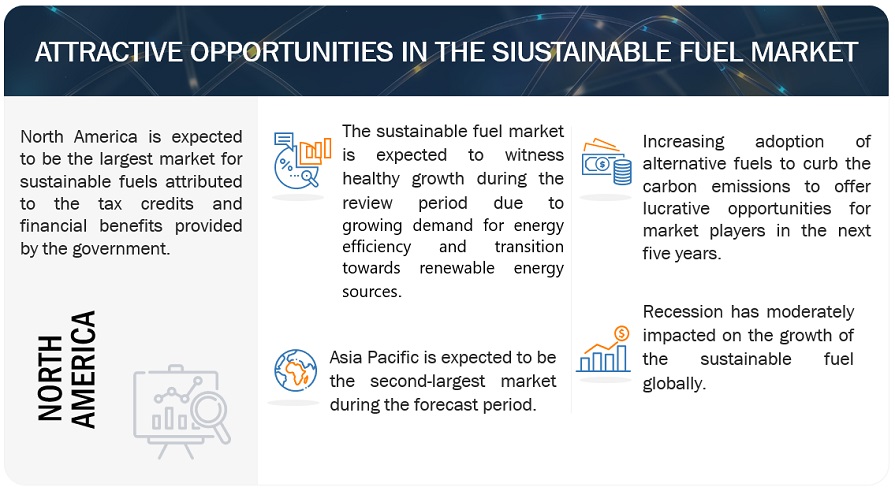
According to a research report, the global Sustainable Fuel Market is projected to reach USD 299.9 billion by 2029 from an estimated USD 193.8 billion in 2024, at a CAGR of 9.1% during the forecast period.
Globally, stronger environmental regulations and policies need a reduction in carbon emissions. Governments enforce this through carbon price, emissions trading networks, and transportation-specific regulations. These approaches promote the use of sustainable fuels in order to satisfy regulatory responsibilities. Furthermore, governments throughout the world are establishing blending regulations, which mandate a certain percentage of sustainable fuels to be combined with traditional fuels. These regulations drive the market for sustainable fuels by assuring a steady demand. Furthermore, individuals are increasingly selecting environmentally friendly products and services. This shift in customer behavior puts pressure on businesses to adopt sustainable practices, such as the use of renewable energy.
Key Market Players
Some of the major players in the sustainable fuel market are ADM (US), Shell plc (UK), Siemens Energy AG (Germany), Saudi Arabian Oil Co. (Saudi Arabia), and Chevron Corporation (US) among others. The major strategies adopted by these players include new product launches, acquisitions, contracts, agreements, partnerships, joint ventures, collaborations, investments, and expansions.
Download PDF Brochure:- https://www.marketsandmarkets.com/pdfdownloadNew.asp?id=68114533
E-fuels, by Fuel type, are expected to be the fastest-growing segment during the forecast period.
Advances in e-fuel production technology, such as more effective electrolysis and carbon capture systems, reduce production costs and improve the viability of large-scale e-fuel production, making it more appealing to investors and customers. E-fuels may be generated domestically using renewable resources, lowering reliance on imported fossil fuels and improving national energy security. This characteristic is especially enticing to countries seeking greater energy independence. Many businesses are implementing environmental initiatives to minimize their carbon footprints. Using e-fuels allows these firms to satisfy their sustainability goals and improve their environmental image, which supports market growth. As manufacturing methods develop and scale up, the cost of e-fuels falls, making them more competitive with conventional fossil fuels. This cost reduction fosters broader use throughout various Sectors.

Low Carbon Fossil Fuels, by type, is expected to be the fastest-growing segment during the forecast period.
The expansion of low-carbon fossil fuels is driven by rising consumer and industrial demand for greener energy sources. This demand stems from environmental awareness and a need for sustainable energy alternatives. Aside from that, when economies of scale are attained and manufacturing techniques grow more efficient, the cost of low-carbon fossil fuels falls, allowing them to compete with traditional fossil fuels. Significant investment and finance from both the public and private sectors support research, development, and infrastructure for low-carbon fossil fuel initiatives, promoting market innovation and growth. Furthermore, supportive government policies, such as subsidies, tax breaks, and renewable energy requirements, promote investment in low-carbon fossil fuel projects and drive market expansion.
Request Sample Pages:- https://www.marketsandmarkets.com/requestsampleNew.asp?id=68114533
Asia Pacific is expected to be the fastest-growing region during the forecast period.
Governments in the Asia Pacific are enacting legislation and regulations to promote the use of sustainable aviation fuels (SAF). These policies include incentives, subsidies, and requirements to use SAF, all of which encourage market growth. Consumers and companies are becoming more conscious of traditional aviation fuels’ environmental effects. This knowledge pushes stakeholders to seek sustainable alternatives, resulting in the rapid rise of the SAF industry. Collaboration among governments, industrial businesses, research institutes, and other stakeholders promotes innovation and market expansion. These ties facilitate information sharing, technology transfer, and collaborative efforts to address challenges to SAF implementation. Investments in infrastructure for sustainable fuel production, delivery, and consumption are important for Asia Pacific’s SAF market expansion. Developing good infrastructure makes SAF more accessible and inexpensive, encouraging greater usage.


